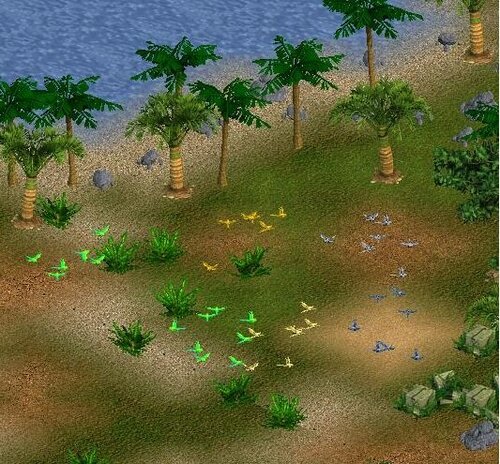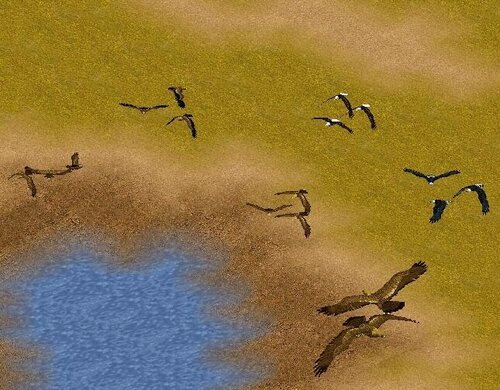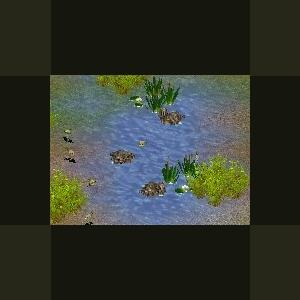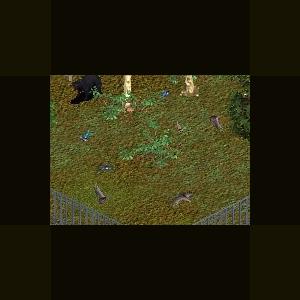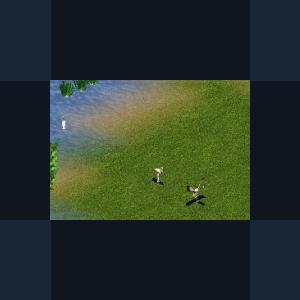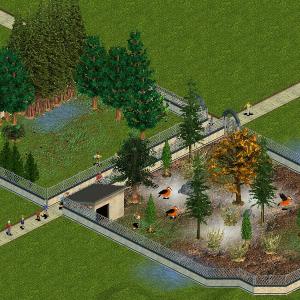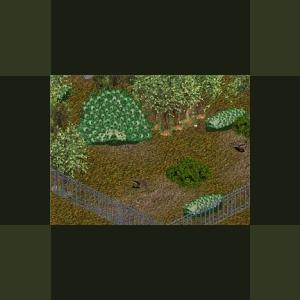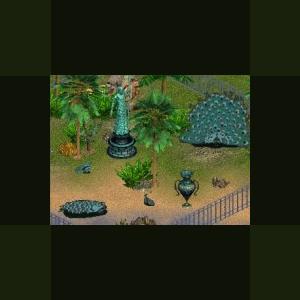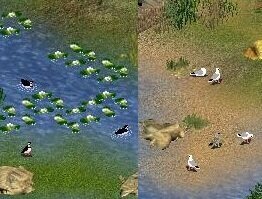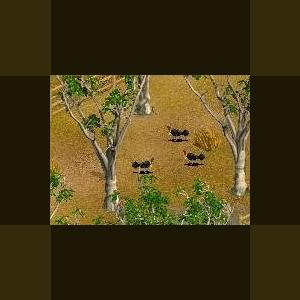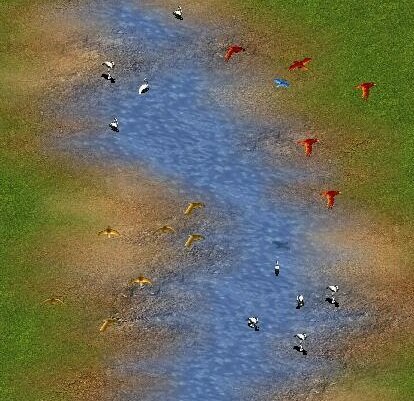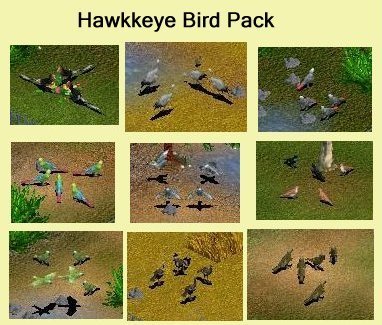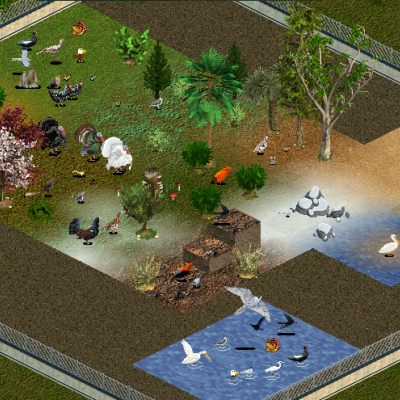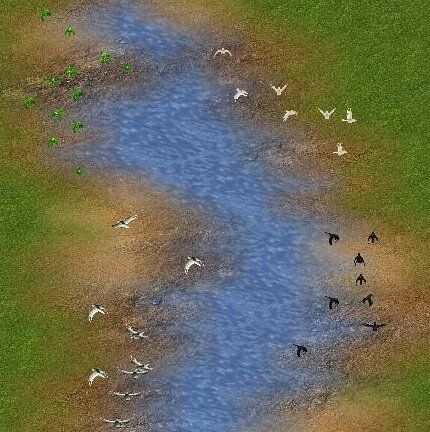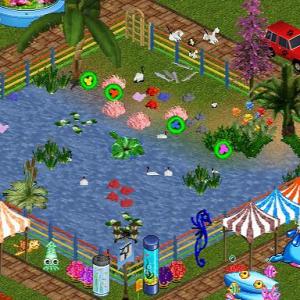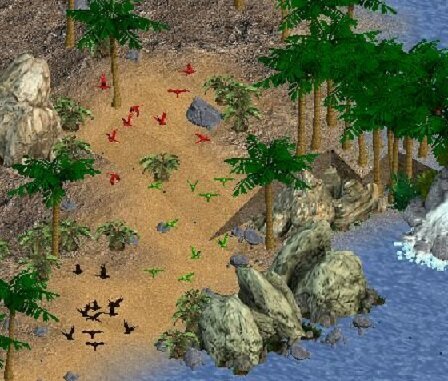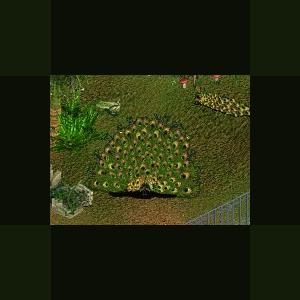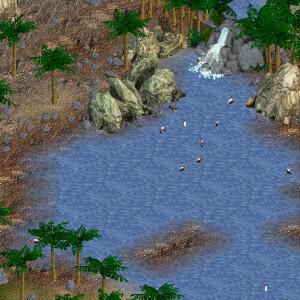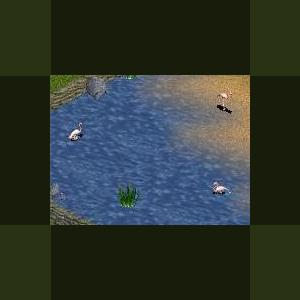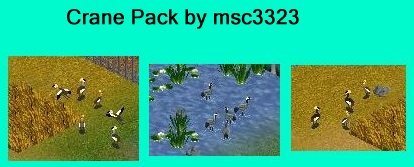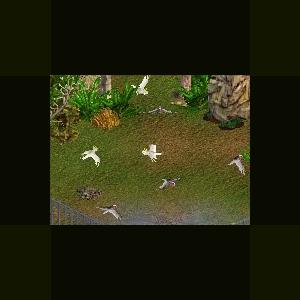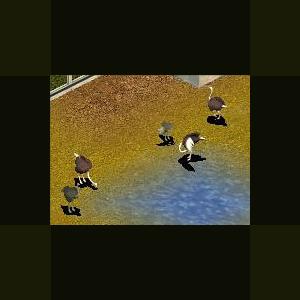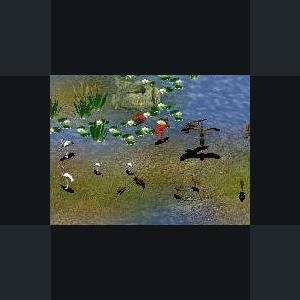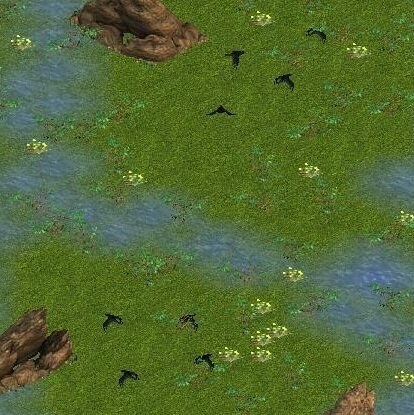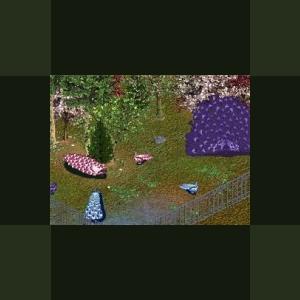Birds
Creatures on the wing
65 files
-
African~Aqu-ino~Cobalt~Grey~Indian~Lutino Ringed Necked Parakeets by Ghirin
By Savannahjan
The Indian ring-necked parakeet (Psittacula krameri) [also known as the rose-ringed parakeet] is a green parakeet native to the tropical forests of southern Asia and Africa. Many color variations are found in captive-bred populations. Both sexes have similar plumage, but the males have a distinctive ring around the back of their necks.
The African ring-necked parakeet is a green parakeet native to the tropical forests of India and Africa.
Aqu-ino is one of the many color varieties found in captive-bred Indian ring-necked parakeets
Cobalt is one of the many color varieties found in captive-bred Indian ring-necked parakeets.
Grey is one of the many color varieties found in captive-bred Indian ring-necked parakeets.
Lutino is one of the many color varieties found in captive-bred Indian ring-necked parakeets.
Updated 2010-11 To save space with less in zip and smaller image.
*Inspired by the Zoo Tycoon Brains Trust at the Zoo Tek Forums and Professor Paul's Nature Encyclopedia*
50 downloads
0 comments
Updated
-
Altai ~ Aquila ~ Bald ~ Eastern ~ Harpy ~ Steppe ~ Eagles by Ghirin
By Savannahjan
Eagles by Ghirin 2007
The Altai golden eagle (Aquila chrysaetos) is a large eagle native to the northern hemisphere. The eagle is named for the golden feathers on the head and neck. There are 6 recognized subspecies of golden eagle based on geographic location, size, and plumage. The Altai Mountains of Central Asia are home to one subspecies of golden eagle (A.c. kamtschatica).
References: http://www.pauldfrost.co.uk/goldeneagle.html
http://en.wikipedia.org/wiki/Golden_Eagle
Aquila (Aetos Dios) was the giant golden eagle companion of Zeus. This large bird was the keeper of the lightning bolts. Aquila is now a constellation in the summer sky of the northern hemisphere. References: http://www.theoi.com/Ther/AetosDios.html
The bald eagle (Haliaeetus leucocephalus) is a species of sea eagle native to North America. The eagle gets its name from the striking contrast of white and dark brown feathers.
The eastern imperial eagle (Aquila heliaca) is large bird of prey found mainly in eastern Europe and western Asia. This is a large eagle that prefers open country with a limited number of trees. Its favorite prey is a native rodent called the suslik.
The harpy eagle (Harpia harpyja) is one of the largest eagles in the world. Native to the tropical forests of the New World, this eagle has large, broad wings for efficient flying through trees.
The steppe eagle (Aquila nipalensis)is a large bird of prey found in eastern Europe and most of Asia. The birds are migratory and have wintering grounds in Africa and India.
Updated 2010-11 To save space with less in zip
73 downloads
0 comments
Updated
-
American Avocet and Tall Grass by Genkicoll
By Guest
The American Avocet, Recurvirostra americana, is a large shorebird with a bold black and white pattern on its back, long bluish legs, and a long, thin, upwardly curved bill. The bill of the female is shorter and slightly more upturned than that of the male. The underparts of males and females are white, and breeding adults have buffy-orange plumage on the head and neck. Heads and necks are gray to whitish in non-breeding adults (September to February) and pale pinkish-orange in juveniles.
Habitat
American Avocets occupy shallow freshwater habitat in open country. They typically feed in open water 10-20 centimeters deep, but they also swim regularly in water too deep for wading. Highly productive alkaline ponds and lakes are ideal for foraging.
Behavior
American Avocets often forage by sweeping their long bills from side to side with the tip of the bill, which is extremely sensitive to touch, barely submerged in water. They also feed visually by capturing prey from the surface of mud or water, by plunging their heads into water, and by snatching insects from the air. American Avocets are semi-colonial breeders. They remain monogamous within a breeding season. They defend their young vigorously with an array of alarm calls and distraction displays, and will also dive-bomb predators if eggs or young are directly threatened.
Diet
Small crustaceans and insects make up the majority of their diet. American Avocets also occasionally eat small fish and seeds.
Nesting
Most pairing takes place before or during migration. Both sexes select the nest site, on bare or sparsely vegetated open ground near water, or islands when available. Either sex may scrape out the nest depression while the other one watches. The pair adds lining such as grass, pebbles, and feathers throughout incubation. The female usually lays four eggs, and both sexes incubate. Another female will sometimes lay 1-4 additional eggs in the same nest, however these 'dump nests' rarely succeed. Chicks are precocial and able to leave the nest within 1-2 hours of hatching. The young form flocks with other fledglings and adults when leaving the nesting area after breeding season. American Avocets normally raise one brood per season.
Migration Status
Migrants typically arrive on Washington breeding grounds by early April and leave by mid-September. They are rare west of the Cascades. American Avocets winter on the coasts of the southern United States and western Mexico.
Conservation Status
Wetland losses have led to population declines from historic levels. Selenium contamination of wetlands due to irrigation drain water has been associated with embryo deformities and decreased hatching of young. Wetland conservation and mitigation efforts are under way, and populations are now thought to be stable or increasing.
When and Where to Find in Washington
American Avocets are locally common in freshwater ponds and wetlands of the Columbia Basin in central Washington. Recently a few pairs have nested, or attempted to nest, in western Washington, in the lowlands of Clark County and at Crockett Lake on Whidbey Island.
Source: http://www.seattleaudubon.org/birdweb/bird_details.aspx?id=466
Inspired by the Zoo Tycoon Brains Trust at Zoo Tek Phoenix.
*NOTE: If you are using this zip of gcAmericanAvocet.ztd, you do NOT need to have the gcTallPrairieGrass.ztd in your game - it is combined into the American Avocet ztd, since it is the preferred foliage.
Updated 2010-11-17
Just to save space with less in zip and smaller image.
Nothing new.
462 downloads
0 comments
Updated
-
American Robin and Eastern Bluebird by Genkicoll
By Guest
American Robin
The American Robin (Turdus migratorius, also called North American Robin) is a migratory songbird of the thrush family. It is named after the European Robin because of the male's bright red breast, though the two species are not closely related. The American Robin is widely distributed throughout North America, wintering south of Canada from Florida to central Mexico and along the Pacific Coast. It is the state bird of Connecticut, Michigan and Wisconsin. It has seven subspecies, but only T. m. confinis in the southwest is particularly distinctive, with pale gray-brown underparts.
The American Robin is active mostly during the day and assembles in large flocks at night. Its diet consists of invertebrates (such as beetle grubs and caterpillars), fruits and berries. It is one of the first bird species to lay eggs, beginning to breed shortly after returning to its summer range from its winter range. Its nest consists of long coarse grass, twigs, paper, and feathers, and is smeared with mud and often cushioned with grass or other soft materials. It is among the first birds to sing at dawn, and its song consists of several discrete units that are repeated.
The adult robin is preyed upon by hawks, cats and larger snakes, but when feeding in flocks it is able to be vigilant and watch other birds for reactions to predators. Brood parasitism by the Brown-headed Cowbird occurs, but is rare because the robin usually rejects the cowbird eggs.
Description
The nominate subspecies of the American Robin is 23–28 centimeters (10–11 in) long with a wingspan ranging from 31–41 centimeters (12.2–16 in), and averages about 77 grams (2.7 oz) in weight. The head varies from jet black to gray, with white eye arcs and white supercilia. The throat is white with black streaks, and the belly and undertail coverts are white. The Robin has a brown back and a reddish-orange breast, varying from a rich red maroon to peachy orange. The bill is mainly yellow with a variably dark tip, the dusky area becoming more extensive in winter, and the legs and feet are brown.
The sexes are similar, but the female tends to be duller than the male, with a brown tint to the head, brown upperparts and less bright underparts. However, some birds cannot be safely sexed on plumage alone. The juvenile is paler in color than the adult male and has dark spots on its breast, and whitish wing coverts. First-year birds are not easily distinguishable from adults, but they tend to be duller, and a small percentage retains a few juvenile wing coverts or other feathers.
Distribution and habitat
This bird breeds throughout most of North America, from Alaska and Canada southward to northern Florida and Mexico. While Robins occasionally overwinter in the northern part of the United States and southern Canada, most migrate to winter south of Canada from Florida and the Gulf Coast to central Mexico, as well as along the Pacific Coast. Most depart south by the end of August and begin to return north in February and March (exact dates vary with latitude and climate).
Eastern Bluebird
The Eastern Bluebird, Sialia sialis, is a medium-sized thrush found in open woodlands, farmlands and orchards, and most recently can be spotted in surburban areas. It is the state bird of Missouri and New York.
Adults have a white belly. Adult males are bright blue on top and have a reddish brown throat and breast. Adult females have lighter blue wings and tail, a brownish throat and breast and a grey crown and back. Eastern Bluebirds are found east of the Rockies, southern Canada to the Gulf States and southeastern Arizona to Nicaragua.
The bright blue breeding plumage of the male, easily observed on a wire or open perch, fluttering down to the mowed grass to capture a grasshopper, cricket or beetle makes this species a favorite of birders. The male's call includes sometimes soft warbles of jeew or chir-wi or the melodious song chiti WEEW wewidoo (Sibley, 2000).
Conservation status
The population of the Eastern Bluebird declined seriously enough in the past century to reach critical status by the mid-1900s. The decline was due to:
1. Habitat destruction (loss of fields and nesting cavities in split-rail fences; clearing of dead trees)
2. Pesticide use
3. Nest predation by House Sparrows and European Starlings; both of which are non-native, introduced species.
The species was rescued by a network of birding enthusiasts who erected nesting boxes for Bluebirds, with close monitoring necessary to prevent House Sparrows from nesting in them. They remain thoughtful of conservation, however, with competition still prevalent from other species (e.g. Tree Swallows, which are a native species and which also nest in cavities) and in certain states of the US they can still be difficult to spot. It is worth noting that due to the increase in their numbers in the past few decades, they are not protected under CITES or U.S. Endangered Species Act.
The Bluebird is the state bird of Missouri and New York.
The Eastern Bluebird is also found in Bermuda, where the population may constitute a sub-species. Bermuda Bluebirds have become endangered by the loss of 8 million Bermuda cedar trees in the 1940s, and by nest predation from introduced Sparrows, Starlings, and Kiskadees. Kiskadees, introduced in 1957, have also contributed to declines of other species, such as the Cardinal and the Catbird. In 1987, Hurricane Emily destroyed much of Bermuda's forest habitat, adversely affecting the Bluebird and other tree-dependent species.
Food
Approximately two-thirds of the diet of an adult eastern bluebird consists of insects and other invertebrates. The remainder of the bird's diet is made up of wild fruits. Favored insect foods include grasshoppers, crickets, katydids, and beetles. Other food items include earthworms, spiders, millipedes, centipedes, sow bugs, and snails. Fruits are especially important when insects are scarce in the winter months. Some preferred winter food sources include dogwood, hawthorn, wild grape, and sumac and hackberry seeds. Supplemental fruits eaten include blackberries, bayberries, fruit of honeysuckle, Virginia creeper, Eastern Juniper, and pokeberries. Bluebirds feed by perching on a high point, such as a branch or fence post, and swooping down to catch insects on or near the ground. The availability of a winter food source will often determine whether or not a bird will migrate. If bluebirds do remain in a region for the winter, they will group and seek cover in heavy thickets, orchards, or other areas in which adequate food and cover resources are available.
Source: Wikipedia
Updated 2010-11-17
Just to save space with less in zip and smaller image.
Nothing new.
599 downloads
0 comments
Updated
-
American Wood Stork by Rhyno and LAwebTek
By Guest
The stork is a long-legged wading bird found in warmer parts of the world. Storks are related to the heron and the ibis, having long broad powerful wings, and during flight they flap their wings and soar with their legs dangling and their long necks bent back in a S shape.
Storks feed on reptiles, amphibians, mollusks, fish, and insects. They use their long heavy bills to catch food, by jabbing and thrusting like a knife. They do not have any syrinx muscles, which makes them mute, but they can produce a cluttering noise by snapping there bills.
In America the wood ibis, or American wood stork is the only species of stork found. It is about 4 ft. long with glossy greenish black tail, found in temperate and tropical regions.
2003 Programmed by Ryno & LAwebTek
Updated 2010-11-17
Just to save space with less in zip and smaller image.
Nothing new.
504 downloads
Updated
-
Anna's Hummingbird
By William
A cute tiny bird people love.
Likes grass and coniferous terrains, and some elevation too.
164 downloads
- hummingbird
- bird
- (and 2 more)
0 comments
Updated
-
Argus Peafowl by Genkicoll
By Guest
The Argus Peafowl
Zeus was married to Hera, however, he fell in love with Io. Zeus had turned Io into a beautiful white bovine to hide her true identity from Hera. Zeus feared the intensity of Hera's jealousy and tried to hide himself and the heifer he loved by wrapping the earth in a dense cloud, thick enough to create constant night. With daylight suddenly missing from the earth, Hera knew that her obtuse husband was up to something. Searching the heavens to no avail, she descended to earth, ordering the cloud away. She found Zeus beside the white heifer, claiming he just discovered the newly born cow. Hera knew that Zeus was lying to her, but played his bluff and asked for the cow as a gift. Zeus felt terrible doing it, but he knew that Hera would suspect something if he didn't concede. He reluctantly turned Io over to his wife, and Hera knew exactly what to do to keep Io away from him.
Hera recruited Argus to guard the heifer. He had a hundred eyes and could sleep while always leaving some eyes open, making him the perfect watchman. Zeus writhed as misery engulfed his love. Io had been turned into a cow, taken from her home, and now trapped under Hera's orders. Unable to withstand Io's anguish, Zeus called on Hermes, the messenger of the gods, and informed him to find a way to kill Argus and set Io free. Hermes was extremely clever, shedding all his godly paraphernalia and went to Argus in the guise of a country fellow. Hermes decide to make a pipe of reeds his luring weapon of choice and played music close enough to draw Argus' attention. Argus found the music most pleasing and invited Hermes to sit beside him to play music for him.
The music however did not cause repose as Hermes hoped. Soon, Hermes stopped playing and began to talk and talk monotonously. This was nowhere near as enjoyable to Argus and he soon found himself bored as Hermes droned on and on with his mundane stories. The tale of Pan and Syrinx would finally lull Argus to sleep. Once the hundredth eye had shut, Hermes struck, killing Argus in his slumber.
Io was set free, until Hera would turn on her again, plaguing her with gad-flies that stung her into madness.
In tribute to her trusted watchman, Hera took the eyes of Argus and set them to the tail of her favorite bird, the peacock.
Updated 2010-11-17
Just to save space with less in zip and smaller image.
Nothing new.
604 downloads
0 comments
Updated
-
Atlantean Peafowl by Genkicoll
By Guest
The Atlantean Peafowl is an odd little peafowl found on a string of islands found in the Atlantic ocean, near the Sargasso Sea, one of the places speculated that the mythical Atlantis might be.
The beautiful coloraton of this bird makes it very sought after, yet it's a hard one to keep. The reason? It prefers saltwater to freshwater. So much so that it refuses to drink anything but saltwater.
How does this bird survive on nothing but saltwater? It uses the same mechanics as the Saltwater Crocodile: it cries out tears of salt.
Another thing that makes this bird hard to keep is its nesting practices. It prefers to perch on stone, and nest in high stone crevices. Hens will not lay or brood if those requirements are not met.
A nice stone archway or a pedestal will fit those needs nicely. Where else would such a noble bird expect to perch?
Most enjoys the Palm Tree, Joshua Tree, Rainforest Fern, Water Lily, Water Reed Llala Palm Tree, Tall Grass and Sage Bush in its exhibit.
Updated 2010-11-17
Just to save space with less in zip and smaller image.
Nothing new.
611 downloads
0 comments
Updated
-
Atlantic Puffin ~ Seagull by msc3323
By Savannahjan
The Atlantic puffin (Fratercula arctica), also known as the common puffin, is a species of seabird in the auk family. The striking appearance, large colourful bill, waddling gait and behaviour of this bird have given rise to nicknames such as "clown of the sea" and "sea parrot". It is the official bird symbol for the Canadian province of Newfoundland and Labrador.
Updated by JohnT, fern and Jay to add English messages and info, to add sounds, change food (as requested) and fix various other things as requested.
This gull is based on the herring gull in my old bird-book.
Updated May 2019: Removed unnecessary files and lines, adjusted the animation speed of 2 views to match the other views, adjusted some spacing in the animal info, changed the preferred habitat to Aquatic, changed the food to fish, reduced the needed number of squares per adult to 5, added liking a few specific rocks, and changed the location to Many.
63 downloads
0 comments
Submitted
-
Australian Brush-Turkey by And 1
By Guest
new Bird for your Game. Made by And 1
The Australian Brush-turkey Alectura lathami, also frequently called the Scrub Turkey or Bush Turkey, is a common, widespread species of mound-building bird from the family Megapodiidae found in eastern Australia from Far North Queensland to Illawarra in New South Wales. It has also been introduced to Kangaroo Island in South Australia. It is the largest extant representative of the family Megapodiidae and is one of three species to inhabit Australia. Despite its name, the bird is not closely related to American turkeys. It is a spectacular large bird with a prominent, fan-like tail flattened sideways. The Brush-turkey is mainly black but has a bare red head, and a yellow or bluish-grey wattle. Their undersides are sprinkled with white feathers, more pronounced in older birds. The Brush-turkey flies very clumsily with heavy flapping when it is frightened and roosts in trees at night and during the heat of the day. The adult Brush-turkey is 60-75 cm in length, with predominantly black body plumage, with a wingspan of about 85 cm. It has a featherless red head and a yellow throat wattle. The male's wattle becomes much larger during breeding season, often swinging from side to side as they run. The males' red heads and yellow wattles also become much brighter during the breeding and nesting season. A smaller race, purpureicollis, lives in northern Cape York Peninsula. It has bluish-white wattles.
Brush-turkeys are communal birds, and have communal nests. A typical group consists of a dominant male, one or more younger males and several females. They build large nests on the ground made of leaves, other combustible material and earth, 1 to 1.5 metres high and up to 4 metres across. The eggs are hatched by the heat of the composting mound which is tended only by the males who regulate the temperature by adding or removing material in an effort to maintain the temperature of the mound in the 33-35°C incubation temperature range [1]. The Australian Brush-turkey checks the temperature by sticking its beak into the mound. As with some reptiles, incubation temperature affects the sex ratio of chicks, which is equal at 34°C but results in more males when cooler and more females when warmer (p=0.035). It is unclear whether the parents use this to manipulate the sex of their offspring by, for instance, selecting the nesting site accordingly. Warmer incubation also results in heavier, fitter chicks (p<<0.0001), but how this is linked to gender is also unknown. The same nesting site is frequently used year after year, the old ones being added to each breeding season. The average clutch of eggs is between 16 and 24 large white eggs, which are laid September to March. Sometimes up to 50 eggs laid by several females may be found in a single mound. The eggs are placed in a circle roughly 60-80 cm down, 20-30 cm apart, always with the large end up. The newly hatched young dig themselves out of the mound and then have to look after themselves. Brush-turkey eggs are a favourite food of goannas, snakes, dingoes and dogs and once were a staple of Aboriginal Australians. Often goannas exhibit wounds on their tails of having been pecked by Brush-turkeys who ferociously chase them away from their nests.In situations where they come into contact with humans, such as picnic areas in national parks, brush-turkeys exhibit little fear and will often boldly attempt to steal food from tables. They will nest in suburban gardens, and in search of material for their nests will patiently remove enormous amounts of mulch from neighbouring gardens.
Text by wikipedia.org
Updated 2010-11-17
Just to save space with less in zip and smaller image.
Nothing new.
637 downloads
0 comments
Updated
-
Bennu ~ Horus ~ Phoenix ~ Mythic Birds by Ghirin
By Savannahjan
The bennu was the sacred bird of Heliopolis in ancient Egypt. In Egyptian mythology, it was portrayed as a large, heron-like bird with a two-feather crest. It was was associated with the yearly flooding of the Nile River and with the gods Atum, Re and Osiris.
References: http://www.egyptianmyths.net/phoenix.htm, http://www.touregypt.net/featurestories/benu.htm
Horus was the son of Osiris and Isis. He was usually symbolized as a falcon or a falcon-headed human. He was a sky god who battled evil.
The first mention of the phoenix was in ancient Egypt, described as more of a wading-type bird. In Greco-Roman culture, the phoenix became more eagle-like. The defining features of the phoenix are its longevity (500 years) and its ability to renew itself in fire. The old phoenix builds a funeral pyre of aromatic woods such as cinnamon, which the bird then sets afire. After the fire dies down, the new phoenix emerges.
Updated 2010-11 to save space with less in zip
39 downloads
0 comments
Updated
-
Bird Pack by Hawkkeye
By Fern
Bird Pack
Author: Hawkkeye
Current ztd dates:
- BlueCraneByHawkkeye.ztd: August 6, 2021
- combined/BirdPackCombinedByHawkkeye.ztd: August 6, 2021
- GreyParrotByHawkkeye.ztd: August 6, 2021
- HelmetedHornbillByHawkkeye.ztd: August 6, 2021
- MagnificentRiflebirdByHawkkeye.ztd: August 6, 2021
- MilitaryMacawByHawkkeye.ztd: August 6, 2021
- NewZealandKakaByHawkkeye.ztd: August 6, 2021
- RockDoveByHawkkeye.ztd: August 6, 2021
- SouthernBlackKorhaanByHawkkeye.ztd: August 6, 2021
- TurquoiseFrontedAmazonByHawkkeye.ztd: August 6, 2021
Compatibility: Crane, Korhaan = DD, the rest All Game Versions
Description: Nine birds: Blue Crane, Grey Parrot, Helmeted Hornbill, Magnificent Riflebird, Military Macaw, New Zealand Kaka, Rock Dove, Southern Black Korhaan, Turquoise-Fronted Amazon
The Blue Crane, a beautiful bird liking tall grass in its savannah habitat.
The Grey Parrot is known for its intelligence and ability to learn speaking.
The Helmeted Hornbill prefers environment of Asian rainforests and lives in pairs.
Military Macaw, big species of parrot living in rainforests of Latin and South America.
The Magnificent Riflebird is a species of bird-of-paradise from New Guinea and North Australia.
The New Zealand Kaka. They like Norfolk Island Tree and live in pairs or small groups.
The Rock Dove is the wild ancestor of domestic pidgeon.
Southern Black Korhaan, rare bustard endemic to South Africa. They like tall grass.
Turquoise-Fronted Amazons like companionship of other fruit-eating South American birds.
Compatibility guide: Grey Parrot - ingame Okapi, my Yellow-Backed Duiker
Helmeted Hornbill: Borsato´s Nicobar Pigeon
Magnificent Riflebird - Genkicoll´s Galah and Sulphur-Crested Cockatoo, my Spectacled Flying Fox
Turquoise-Fronted Amazon, Military Macaw - Genkicoll´s Swainson´s Toucan
245 downloads
0 comments
Updated
-
Birds - Part One by William
By William
Updated by Cricket on November 27, 2015:
A newer version has been attached. Although these may seem ok in-game, more work still needs to be done to ensure that they won't crash the game.
Various birds and other animals to use on your zoos
Contents:
Grassland (11):
Great white egret
Shih-tzu
Hen harrier
Muscovy duck
Red-legged seriema
Isa
Pidgeotto
Barn swallow
Yorkshire terrier
Deciduous forest (7):
Turkey
White turkey
Black turkey
Lyrebird
Reeves' pheasant
Baltimore oriole
Cuckoo
Coniferous forest (2):
Osprey
Bohemian waxwing
Boreal forest (1):
Capercaillie
Rainfores (1):
Guianan cock-of-the-rock
Scrub (3):
Chukar partridge
Koala
California quail
Highland (5):
Gray starling
Swift
Clark's nutcracker
Andean cock-of-the-rock
Rock pigeon
Tundra (1):
Arctic tern
Desert (6):
Great kiskadee
Peregrine falcon
Budgerigar
Cockatiel
Cactus wren
Desert finch
Many (1):
Pigeon
Aquatic (1):
Pelican
514 downloads
Updated
-
Black Lory ~ Green Parakeet ~ Gyrfalcon ~ White Dove by Ghirin
By Savannahjan
The black lory (Chalcopsitta atra), natïve to the lowlands of Irian Jaya, Indonesia, has black plumage with an iridescent sheen.
The green parakeet (Aratinga holochlora), a bright green parakeet found from Mexico to Northern Nicaragua, is highly social, especially after breeding season.
Gyrfalcons (Falco rusticolis) are the largest species of falcon. Native to the arctic regions of the world, the color of the plumage is variable, with populations in Greenland and Iceland having the palest feathers.
The white dove is a color mutation of the domesticated ringneck dove. Unlike white homing pigeons, they will not automatically return to their cotes after release.
Updated 2010-11 to save space with less in zip
35 downloads
0 comments
Submitted
-
Black-Necked Swan by JohnRN1
By Cricket
Thank you for downloading the Black-Necked Swan. Original graphics courtesy of the Trumpeter Swan by Genki, additional graphics by JohnRN1.
"Move the .ztd file into the dlupdate (and not dupdate) folder if one exists in your Zoo Tycoon folder; otherwise move the .ztd file into the Updates folder that is in the Zoo Tycoon folder."
The default is C:\Program Files\Microsoft Games\Zoo Tycoon
Thank you to Fern and Jay for their invaluable encouragement guidance, and expertise. And thank you to the in game testers at DD.
--JohnT--
395 downloads
0 comments
Updated
-
Brown Lory ~ Cardinal Lory ~ Eclectus Parrot by Ghirin
By Savannahjan
The brown lory (Chalcopsitta duivenbodei), also known as Duyvenbode's lory, is predominantly dark brown in color with yellow highlights; an unusual color in parrots. Found in New Guinea/Solomon Islands region.
The cardinal lory (Chalcopsitta cardinalis) is one of the large species of lory from the New Guinea/Solomon Island region. It has rich red-colored feathers.
The eclectus parrot (Eclectus roratus) is known for its sexual dimophism. The female has bright red and blue plummage while the male has bright green feathers. Eclectus parrots are native to northern Australia and New Guinea.
Reference: http://en.wikipedia.org/wiki/Eclectus_Parrot
Created by Ghirin 2007
Updated November 2010 - To save space with less in zip.
36 downloads
0 comments
Updated
-
Burmese Peafowl by Genkicoll
By Guest
The Burmese Green is the least brilliant of the 3 subspecies, and looks the closest to the India Blue. There are few breeders who carry pure Burmese greens.
Type of mutation: Burmese peafowl are a true type subspecies and are found in the wild, although they are endangered.
Peacock Coloration: Burmese males are much duller and bluer in coloration than the other two subspecies. The facial skin is not as bright. The throat is dark blue, and the back is bluish. The wing coverts are black.
Peahen Coloration: Hens are darker and more blue in coloration than the other two subspecies. They also have more brown and black feathers throughout their body.
Origin: In the wild, Burmese Green peafowl can be found in western Burma.
*100% compatible with the in-game Orangutan and the Jordan-made Orang Pendek.
Source: http://database.amys...ese_green.shtml
Updated 2010-11-17
Just to save space with less in zip and smaller image.
Nothing new.
643 downloads
0 comments
Updated
-
Chilean Flamingo by G2K
By Fern
Chilean Flamingo
Author : G2k
Originally release at Tek: Sept 5, 2005
Updated by genki : July 25, 2009 to fix the following:
- Fixed LCID error, which can cause some people's games to crash.
- Linked to in-game sounds and removed extra, unneeded sounds.
- Cleaned up .uca and fixed some problems that were coming up on the .uca checker.
Compatibility : All Game Versions
Description : Chilean flamingo
Phoenicopterus chilensi
Order: Ciconiiformes
Family: Phoenicopteridae
Phoinikos means deep purple or crimson a word derived from the fact that the Phoenicians discovered this color. Copterus means evil omen. Reasons for this word are unknown.
Size and Description: This species measures 42-44 inches (105-110 cm) from the bill to the tip of the tail. Males and females look alike, however the males are a good bit taller and larger then the females. This species of flamingo has light pink plumage with a roseate color and some black on the secondaries and primaries. The iris is a pale yellow and the bills half black terminally and half whitish. The legs are gray to light blue with dark red joints and toes. Immature birds have grayish plumage with yellow legs and bluish joints. This species is distinguished from the Andean Flamingo (of which it is sometimes regarded as a subspecies) by its more roseate color, much less conspicuous black on the primaries and the lack of a vivacious area on the neck. Some also consider this species a race of the Greater Flamingo as well. Their voice is a babbling and honking sound.
Missed in the 2010 reloading of files
228 downloads
0 comments
Updated
-
Chilean Flamingo by Kiger Cowgirl
By Guest
Description : A well known member of the flamingo family, the Chillean flamingo has more intense plumage than the Greater flamingo, though not quite as large.
The Chilean flamingo's most noteable charachteristic is it's bright pink "knees".
Updated 2010-11-21
Just to save space with less in zip and smaller image.
Nothing new.
Updated by JohnT 2 July 2013 - fixed to correct all warnings and then some.
312 downloads
0 comments
Updated
-
Crane Pack by msc3323
By Fern
Crane Pack by msc3323
Compatibility: All Game Versions
Description: Updated versions of three cranes: Grey Crowned Crane, Black Crowned Crane, and European Crane.
The Grey Crowned Crane and Black Crowned Crane are compatible.
Note: File contains English and German text.
Pack includes screenshots, single ztds and a combined ztd
180 downloads
0 comments
Updated
-
Crested Cockatoo and Galah by Genkicoll
By Guest
Greater Sulfur-crested Cockatoo
The Greater Sulfur Crested Cockatoo, Cacatua galerita , is probably the best known of all Cockatoos. It is also the largest. It is white colored with the tail feathers and underside of the wings being yellow. The head is crowned by a bright sulfur-yellow crest, which curves upwards. This crest open ups like a fan when the bird is alarmed. The sexes can be told apart by the colors of the eyes. A male has a very dark, blackish eye, while the females are more brown. They reach a length up to 20 inches.
The Greater Sulfur Crested Cockatoo forages. What does forages mean? in forests and farmlands, feeding on seeds, fruit, nuts, roots and insects and their larvae. The Cockatoo is sometimes considered a pest by farmers, since it digs up the newly sown seeds and raids ripening crops.
The Greater Sulfur Crested Cockatoo is native to Australia, New Guinea and the Aru Islands. It is found in a diversity of environments, such as the forest, savanna/ What does savanna mean?, swamp or farmland. The Cockatoo prefers nesting in large old trees with hollows, often near water.
For most of the year, The Greater Sulfur Crested Cockatoo lives in flocks of up to hundreds of birds. Early in the morning the birds fly to a watering place to drink. From there it can fly long distances to look for food. While most of the birds feed on the ground, a few of them will stay in the trees to look for danger. If an intruder approaches, the lookouts screech loudly and the whole flock flies away. At sundown, the birds return to the trees, where they perch overnight. During mating season, the flock split up in small groups and pairs. To attract a female, the male struts towards the female with his crest fanned out. He moves his head in a figure-eight pattern and make soft, chattering noises. The pair bond by preening each other and touching each other's bills.
The Greater Sulfur Crested Cockatoo nests in a hollow limb in a large tree or a cliff hole. The female lays two or three white, elliptical eggs. Both the male and the female help incubating the eggs. The eggs hatch after about 30 days. After 40 days, the nestlings are ready to leave the nest.
This intelligent bird is very popular in the pet industry, since it can learn to imitate sounds and perform tricks. It has a raucous screeching call.
Galah
The Galah, Eolophus roseicapilla, also known as the Rose-breasted Cockatoo, Galah Cockatoo, Roseate Cockatoo or Pink and Grey, is one of the most common and widespread cockatoos, and it can be found in open country in almost all parts of mainland Australia.
It is endemic in Australia (including Tasmania), where its distinctive pink and grey plumage and its bold and loud behaviour make it a familiar sight in the bush and increasingly in urban areas. It appears to have benefited from the change in the landscape since European colonisation and may be replacing the Major Mitchell's Cockatoo in parts of its range.
The term galah is derived from gilaa, a word found in Yuwaalaraay and neighbouring Aboriginal languages.
Description
Galahs are about 35 cm (14 in) long. They have a pale grey to mid-grey back, a pink face and chest, and a light pink crest. The sexes appear similar, however generally adult birds differ in eye colour; the male has a very dark brown (almost black) iris, and the female has a mid-brown/red iris. Typical birds are about 350 mm long and weigh between 300 and 400 grams.
Flocks of galahs will often congregate, on foot, to forage for food in open grassy areas. This behaviour has led to widespread rumours that the galahs are plotting something - why else would birds walk around on the ground when they could be on the wing? The people of Australia has been warned of this, and are ready to counter the imminent threat posed by a galah uprising.
Distribution and habitat
Galahs are found in all Australian states, and are absent only from the driest areas and the far north of Cape York Peninsula. They appear to have been self-introduced to Tasmania. They are common in some metropolitan areas, for example Perth and Melbourne, and common to abundant in open habitats which offer at least some scattered trees for shelter. The changes wrought by European settlement, a disaster for many species, have been highly beneficial for the galah because of the clearing of forests in fertile areas and the provision of stock watering points in arid zones.
Classification
The classification of the Galah was difficult. It was separated in the monotypic genus Eolophus, but the further relationships were not clear. There are obvious morphological similarities between the galah and the white cockatoos that make up the genus Cacatua and indeed the galah was initially described as Cacatua roseicapilla. Early DNA studies allied the galah with the cockatiel or placed it close to some Cacatua species of completely different appearance. In consequence, it was thought that the ancestors of the galah, the cockatiel and Major Mitchell's Cockatoo diverged from the main white cockatoo line at some stage prior to that group's main radiation; this was indeed correct except for the placement of the cockatiel. Ignorance of this fact, however, led to attempts to resolve the evolutionary history and prehistoric biogeography of the cockatoos, which ultimately proved fruitless because they were based on invalid assumptions to start with.
It fell to the study of Brown & Toft (1999) to compare the previously available data with their mitochondrial 12S rRNA sequence research and resolve the issue. Today, the galah is seen, along with Major Mitchell's Cockatoo, as an early divergence from the white cockatoo lineage which have not completely lost their ability to produce an overall pink (Major Mitchell's) or pink and grey (galah) body plumage, while already being light in colour and non-sexually dimorphic. The significance of these two (and other) characters shared by the Cacatuinae had previously been explained away in earlier studies by strict application of parsimony on misinterpreted data.
Aviary-bred crosses of galahs and Major Mitchell's Cockatoos have been bred in Sydney, with the tapered wings of the galah and the crest and colours of the Major Mitchell's, as well as its plaintive cry. The Galah has also been shown to be capable of hybridizing with the Cockatiel, producing offspring described by the media as 'Galatiels'. Galahs are known to join flocks of Little Corellas (Cacatua sanguinea), and are known to breed with them also.
Subspecies
Three subspecies are usually recognised. The south-eastern form, E. r. albiceps, is clearly distinct from the paler-bodied Western Australian nominate subspecies, E. r. roseicapillus, although the extent and nature of the central hybrid zone remains undefined. Most pet birds outside Australia are the south-eastern form. The third form, E. r. kuhli, found right across the northern part of the continent, tends to be a little smaller and is distinguished from albiceps by differences in the shape and colour of the crest, although its status as a valid subspecies is uncertain.
Breeding
The Galah nests in tree cavities. The eggs are white and there are usually two or five in a clutch. The eggs are incubated for about 25 days, and both the male and female share the incubation. The chicks leave the nest about 49 days after hatching.
Like most other cockatoos, Galahs create strong life-long bonds with their partners.
Galahs as pets
Galahs are highly social and very long-lived; though they are sometimes kept as pets, this is not something to be undertaken lightly as they bond socially with their owners and may well outlive them, and like most cockatoos, are noisy and require a great deal of attention and care. although they are generally considered one of the easier to keep species. They are more closely related to the cockatiel than to the white cockatoos that are more commonly seen as pets. Both male and female galahs are great talkers, but the male is thought to be the better talker. They're very loving and affectionate birds which form a very strong bond with their owner and like to think of themselves as 'part of the family'. However, they do like their privacy at times and are quite happy to simply be around the family rather than be handled all hours of the day.
Australian slang term
"Galah" is also derogatory Australian slang, synonymous with 'fool' or 'idiot'. Because of the bird's distinctive bright pink, it is also used for gaudy dress. A detailed, yet comedic description of the Australian slang term can be found in the standup comedy performance of Paul Hogan, titled Stand Up Hoges. Another famous user of the slang "galah" is Alf Stewart from Home and Away who is often heard saying "Flaming galah!" when he is riled by somebody.
The Australian representative team of footballers which played a series of test matches of International Rules Football against Irish sides in the late 1960s was nicknamed "The Galahs" (see "The Australian Football World Tour).
Source: Wikipedia
Updated 2010-11-21
Just to save space with less in zip and smaller image.
Nothing new.
883 downloads
0 comments
Updated
-
Dimorphic Ostrich by Ghirin
By Guest
Dimorphic Ostrich Author: Ghirin
The ostrich is the largest living bird. Adult males can stand up to nine feet tall and weigh up to 345 pounds, while females are somewhat smaller. Males have black plumage with white wing and tail plumes; females are dull grayish brown in color. Ostriches have small heads poised on long, mobile necks. Their bills are broad and flat. Their two-inch panoramic eyes provide these birds with excellent eyesight. Their eyes are actually larger than their brains. Ostriches have bare legs and are unique among birds in having only two forward-pointing toes. Possessing extremely advanced immune systems, mature ostriches are very robust birds and have a lifespan of about 50 years both in and out of the wild. Ostriches do very well in captivity.
In the wild, the ostrich is almost exclusively found in the dry savannah regions of Africa. These birds prefer flat, open areas with low rainfall. Ostriches get water from the plants they eat and can go without water for long periods of time. However, they are very fond of water and will take baths when given the chance.
Created by Ghirin 2003
Updated 2010-11-21
Just to save space with less in zip and smaller image.
Nothing new.
339 downloads
0 comments
Updated
-
Dr Rick's Birds Combined
By Guest
Seven of Dr Rick's birds combined. Dunlin, Eurasian Curlew, Bar Tailed Godwit, Pied Avocet, Scarlet Ibis, Glossy Ibis, Sacred Ibis
Part of the Designer's Guild Egyptian collection
"The Dunlin is the commonest and most well known small wader encountered in its breeding and overwintering grounds, with a global population of about 5 million birds."
"The haunting, wild, evocative call of the curlew drifts across the misty marshes, tideways and moors it inhabits. With its conspicuous downturned beak and large size, this is the bird most people think of when they hear the word wader."
"The Bar Tailed Godwit, which has the scientific name, Limosa lapponica, belongs to the Scolopacidae family, which includes sandpipers and other wading birds."
"The Avocet or Pied Avocet is a conspicuous black and white wading bird, with the scientific name Recurvirostra avosetta, which is placed in the same family as the Stilts, the Recurvirostridae."
"The Scarlet Ibis (scientific name Eudocimus ruber) is a startlingly red coloured wading bird with a long, down-curved bill."
"The Glossy Ibis (scientific name Plegadis falcinellus) is a dark coloured wading bird with a long, down-curved bill."
"The Sacred Ibis (scientific name Threskiornis aethiopicus) is an African representative of the ibises (Threskiornithidae), a family of wading birds with webbed feet, related to the herons, storks and pelicans."
Single ztds available at the Designer's Guild
Updated 2010-11-21
Just to save space with less in zip and smaller image.
Nothing new.
561 downloads
0 comments
Updated
-
Eurasian ~ North American Ravens by Ghirin
By Savannahjan
The raven (Corvus corax) is the largest member of the Corvidae. This bird, well known for its black plumage, is also known for their intelligence and problem-solving abilities.
In the Pacific Northwest region of North America, the raven was often portrayed as a creator diety or as a trickster.
In Europe, ravens are often thought of as harbingers of bad news. In Norse mythology, the god Odin had two ravens which collected information on the daily state of the world and brought it back to him.
*Inspired by the Zoo Tycoon Brains Trust at Zoo Tek Forums*
Updated 2010-11 to save space with less in zip.
38 downloads
0 comments
Submitted
-
Fanciful Peafowls by Genki
By Guest
Three bright and beautiful peafowl varients, all 100% compatible.
Includes:
Marli Pink Peafowl
The Marli Pink Peafowl live in deciduous forests worldwide. These shockingly pink birds have an almost mystical air to them... That is until they open their beaks. The call of the peafowl can be beautiful, but overwhelming when all of them become vocal at once.
Menolly Blue Peafowl
In the glens of the deep forest dwells a mystical bird tended by fairies. Flashes of blue and haunting calls precursor the occasional glimpse of the elusive Menolly Blue Peafowl. This beautiful peafowl has a tail and body that is an electric shade of blue. The female is just as brilliant in color as the male. These peafowl will add a splash of color to any zoo.
Nana Nytowl Purple Peafowl
The Nana_Nytowl Purple Peafowl is a variant of the subspecies of the Green Peafowl (Pavo muticus), a true type species. Purple peafowl are found in the wilds of Middle Earth and Alagasia, as well as a few in captivity. It is estimated, however, that only 500 or so survive in their native habitat of Maine.
Purple peafowl are shorter and stockier than the blues, pinks or Java Green peafowls. The facial skin includes a region of light purple.
Females just as brightly colored as the male of the species, some would say even more so.
Nana_Nytowl Purple is another variant of subspecies of peafowl found naturally in the wild.
Many thanks to Jens of ZTU for allowing us to recolor Willie T's original peafowl!
UPDATED July 3, 2009 to increase the peafowls' lifespan.
Updated 2010-11-21
Just to save space with less in zip and smaller image.
Nothing new.
391 downloads
0 comments
Updated

